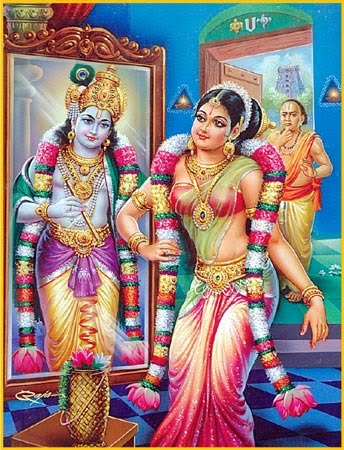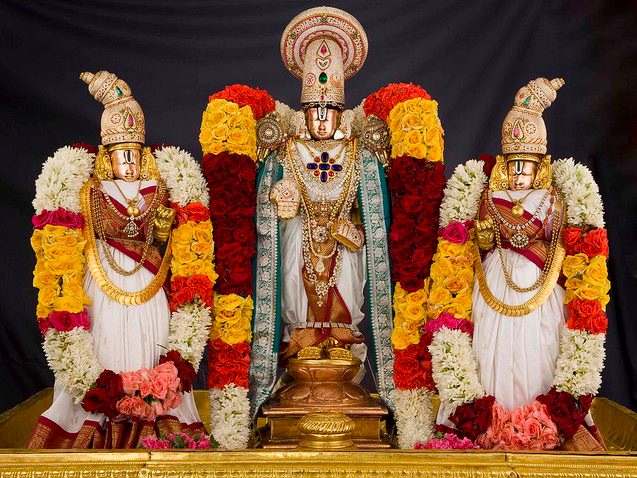Published from “Three Minutes” series written by A.S.Rajagopalan Swami of Ohio.
 vAraNam Ayiram sUzha valam
vAraNam Ayiram sUzha valam
seydu
nAraNa nambi naDakkinRAn
enRu edir
pUraNa poRkuDam vaittup
puRam engum
tOraNam naTTAk kanAk
kaNDEN tOzhi! nAn
ANDAL, nAcciyAr tirumozhi 6-1)
tOzhi! = Oh, my dear friend!
nAraNa = Sriman nArAyaNAn,
nambI = the one with noble characters,
sUzha = in the midst of
Ayiram = thousand
vAraNam = elephants
seydu = doing
valam = a circle (pradakshinA)
naDakkinRAn = walking (entering
inside).
(To give a grand welcome for Him)
enRu = for that
poRkuDam = golden vessels
pUraNa = filled with holy water
edir = were placed in front of Him
puram engum = the whole town
nATTA = is positioned with pillars to
hang
tOraNam = streamers (decorations)
nAn = (thus) I
kanAk kaNDEN = have dreamt.
Here, shrImati gOda pirATTi is describing her dream to her girl friend. “My dear friend, In my dream, my beloved KR^iShNa, Lord ranganAthA, shrIman nArAyaNa who is always brimming with supreme characters, with all His paraphernalia of thousand elephants is walking in a circle (pradakShiNa) and coming inside the wedding hall. [It can also be interpreted that the groom may be circling around the town (Urvalam) and finally coming for the engagement (niscayatArtham)].” To give a grand welcome for Him, the townspeople, led by my father PeriyAzhvAr, carry golden vessels filled with holy water stand in front of Him. The whole town is filled with ribbons, streamers, and other decorations that indicate the majestic festive mood.
Here ANDAL emphasizes some subtle points during the initial steps of the wedding process:
1. Groom doesn’t come to thewedding place empty handed; rather, he comes with all of His troupe, including relatives, friends, and items. From where did He get 1000 elephants? Of course, from his fathers, vasudevar and nandagopan.
2. Groom’s party is cheered and welcomed by the whole town, not just the bride’s family.
3. He walks in circle, making a pradakShiNam, in an auspicious manner.
4. The Groom walks in the old tradition. The Lord displays His simplicity (sausIlyam) and accessibility (saulabhyam)
5. Receiving vessels filled with holy water (pUraNa kumbam) is an indication of a great welcome.
6. Decorations with mango leaves and others are hung all over the town to indicate the festivities.
In modern day shrIvaiShNava weddings, the rituals include:
1. Groom’s party usually arrives, one day before the wedding and are received with proper honors. [auspicious sound (mangaLa vAdyam), fruits, betel leaves & nuts (veRRilai pAkku), holy water to remove evils eyes (Aratti), and sweets ].
2. The groom is actually taken around the town (janvAsam) in an open car (convertible), like the old fashioned introduction to the town. Usually the procession begins from a temple or the marriage hall.
3. Making a circle, pradhakShiNa, is one of the auspicious steps still followed in any ritual including the wedding.
4. Welcoming with vessels filled of holy water is still practice done for any sacred welcome like receiving the Lord, AcArya etc.
What we learn from here:
1. One should remember the wedding day, activities, and primarily, the vows taken. They should be cherished and followed. ANDAL indicates that by starting this decad with elephant. It is a metaphor for memory.
2. The harder you hit the ball on the ground, higher it bounces. She ends with ‘me’ (nAn), like signature at the bottom. In a true shrIvaiShNava spirit, by putting one’s own interest at the bottom and looking to please others, one truly becomes great.
3. “Start off with the right foot”, “Well begun half done”, like those sayings, right is important. Right in both interpretations.
 To the world, he may be just one person; But to me, that one person is the world
To the world, he may be just one person; But to me, that one person is the world









I would like to access the entire three minutes series on Varanamayiram and the linkage to the rituals.
Can I get the information on how to access this?